MoO3/S@g-C3N4 Nanocomposite Structures: Synthesis, Characterization, and Hydrogen Catalytic Performance
Abstract
1. Introduction
2. Experimental
2.1. Chemicals and Reagents
2.2. Nanocomposite Preparation
2.3. Characterization of Nanocomposite
2.4. Hydrogen Catalytic Performance
3. Results and Discussion
3.1. XRD Analysis
3.2. FTIR Structure Analysis
3.3. ESEM and STEM Microscopy
3.4. Surface Area and Pore Size
3.5. UV-Vis Spectroscopy
3.6. Hydrogen Catalytic Performance
4. Conclusions
Author Contributions
Funding
Data Availability Statement
Acknowledgments
Conflicts of Interest
References
- Chen, P.; Huang, W.; Li, K.; Feng, D.; Tong, Y. Copper Incorporated Molybdenum Tri-oxide Nanosheet Realizing High-Efficient Performance for Hydrogen Production. Catalysts 2022, 12, 895. [Google Scholar] [CrossRef]
- Ibrahim, I.D.; Sadiku, E.R.; Jamiru, T.; Hamam, Y.; Alayli, Y.; Eze, A.A. Prospects of nanostructured composite materials for energy harvesting and storage. J. King Saud Univ. Sci. 2020, 32, 758–764. [Google Scholar] [CrossRef]
- Mohamed, F.; Rabia, M.; Shaban, M. Synthesis and characterization of biogenic iron oxides of different nanomorphologies from pomegranate peels for efficient solar hydrogen production. J. Mater. Res. Technol. 2020, 9, 4255–4271. [Google Scholar] [CrossRef]
- Shaban, M.; Ali, S.; Rabia, M. Design and application of nanoporous graphene oxide film for CO2, H2, and C2H2 gases sensing. J. Mater. Res. Technol. 2019, 8, 4510–4520. [Google Scholar] [CrossRef]
- Elsayed, A.M.; Rabia, M.; Shaban, M.; Aly, A.H.; Ahmed, A.M. Preparation of Hex-agonal Nanoporous Al2O3/TiO2/TiN as a Novel Photodetector with High Efficiency. Sci. Rep. 2021, 11, 17572. [Google Scholar] [CrossRef] [PubMed]
- Buller, S.; Strunk, J. Nanostructure in energy conversion. J. Energy Chem. 2016, 25, 171–190. [Google Scholar] [CrossRef]
- Li, G.K.; Guo, J.; Zhang, Y.; Zavabeti, A.; Chen, K.; Guo, Y.; Hu, G.; Fan, X.; Li, G.K. Hydrogen Production from the Air. Nat. Commun. 2022, 13, 5046. [Google Scholar]
- Fujishima, A.; Honda, K. Electrochemical photolysis of water at a semiconductor electrode. Nature 1972, 238, 37–38. [Google Scholar] [CrossRef]
- Wen, J.; Li, X.; Liu, W.; Fang, Y.; Xie, J.; Xu, Y. Photocatalysis fundamentals and surface modification of TiO2 nanomaterials. Chin. J. Catal. 2015, 36, 2049–2070. [Google Scholar] [CrossRef]
- Shah, S.A.; Khan, I.; Yuan, A. MoS2 as a Co-Catalyst for Photocatalytic Hydrogen Production: A Mini Review. Molecules 2022, 27, 3289. [Google Scholar] [CrossRef]
- Luo, L.; Gong, Z.; Ma, J.; Wang, K.; Zhu, H.; Li, K.; Xiong, L.; Guo, X.; Tang, J. Ultrathin sulfur-doped holey carbon nitride nanosheets with superior photocatalytic hydrogen production from water. Appl. Catal. B Environ. 2021, 284, 119742. [Google Scholar] [CrossRef]
- Dai, C.; Liu, B. Conjugated polymers for visible-light-driven photocatalysis. Energy Environ. Sci. 2020, 13, 24–52. [Google Scholar] [CrossRef]
- Fang, J.; Fan, H.; Zhu, Z.; Kong, L.B.; Ma, L. “Dyed” graphitic carbon nitride with greatly extended visible-light-responsive range for hydrogen evolution. J. Catal. 2016, 339, 93–101. [Google Scholar] [CrossRef]
- Xiang, Q.; Yu, J.; Jaroniec, M. Synergetic effect of MoS2 and graphene as cocatalysts for enhanced photocatalytic H2 production activity of TiO2 nanoparticles. J. Am. Chem. Soc. 2012, 134, 6575–6578. [Google Scholar] [CrossRef]
- Su, H.; Lou, H.; Zhao, Z.; Zhou, L.; Pang, Y.; Xie, H.; Rao, C.; Yang, D.; Qiu, X. In-situ Mo doped ZnIn2S4 wrapped MoO3 S-scheme heterojunction via Mo-S bonds to enhance photocatalytic HER. Chem. Eng. J. 2022, 430, 132770. [Google Scholar] [CrossRef]
- Peng, H.; Zhou, K.; Jin, Y.; Zhang, Q.; Liu, J.; Wang, H. Hierarchical nanostructure with ultrafine MoO3 particles-decorated Co(OH)2 nanosheet array on Ag nanowires for promoted hydrogen evolution reaction. Chem. Eng. J. 2022, 429, 132477. [Google Scholar] [CrossRef]
- Lee, D.; Kim, Y.; Kim, H.W.; Choi, M.; Park, N.; Chang, H.; Kwon, Y.; Park, J.H.; Kim, H.J. In situ electrochemically synthesized Pt-MoO3−x nanostructure catalysts for efficient hydrogen evolution reaction. J. Catal. 2022, 381, 1–13. [Google Scholar] [CrossRef]
- Duraisamy, S.; Ganguly, A.; Sharma, P.K.; Benson, J.; Davis, J.; Papakonstantinou, P. One-step hydrothermal synthesis of phase-engineered MoS2/MoO3 electrocatalysts for hydrogen evolution reaction. ACS Appl. Nano Mater. 2021, 4, 2642–2656. [Google Scholar] [CrossRef]
- Chen, P.; Tong, Y.; Wu, C.; Xie, Y. Surface/Interfacial Engineering of Inorganic Low-Dimensional Electrode Materials for Electrocatalysis. Acc. Chem. Res. 2018, 51, 2857–2866. [Google Scholar] [CrossRef]
- Li, Y.; Yin, J.; An, L.; Lu, M.; Sun, K.; Zhao, Y.Q.; Gao, D.; Cheng, F.; Xi, P. FeS2/CoS2 interface nanosheets as efficient bifunctional electrocatalyst for overall water splitting. Small 2018, 14, 1801070. [Google Scholar] [CrossRef]
- Zhang, H.; Xi, B.; Gu, Y.; Chen, W.; Xiong, S. Interface engineering and heterometal doping Mo-NiS/Ni(OH)2 for overall water splitting. Nano Res. 2021, 14, 3466–3473. [Google Scholar] [CrossRef]
- Ding, X.; Xia, Y.; Li, Q.; Dong, S.; Jiao, X.; Chen, D. Interface engineering of Co(OH)2/Ag/FeP hierarchical superstructure as efficient and robust electrocatalyst for overall water splitting. ACS Appl. Mater. Interfaces 2019, 11, 7936–7945. [Google Scholar] [CrossRef]
- Zhang, Y.; Guo, H.; Li, X.; Du, J.; Ren, W.; Song, R. A 3D multi-interface structure of coral-like Fe-Mo-S/Ni3S2@NF using for high-efficiency and stable overall water splitting. Chem. Eng. J. 2021, 404, 126483. [Google Scholar] [CrossRef]
- Li, L.; Zhang, T.; Yan, J.; Cai, X.; Liu, S. P doped MoO3−x nanosheets as efficient and stable electrocatalysts for hydrogen evolution. Small 2017, 13, 1700441. [Google Scholar] [CrossRef]
- Ji, L.; Wang, J.; Teng, X.; Dong, H.; He, X.; Chen, Z. N, P-Doped Molybdenum Carbide Nanofibers for Efficient Hydrogen Production. ACS Appl. Mater. Interfaces 2018, 10, 14632–14640. [Google Scholar] [CrossRef]
- Yan, S.C.; Lv, S.B.; Li, Z.S.; Zou, Z.G. Organic–inorganic composite photocatalyst of gC3N4 and TaON with improved visible light photocatalytic activities. Dalton Trans. 2010, 39, 1488–1491. [Google Scholar] [CrossRef]
- Wang, Y.; Shi, R.; Lin, J.; Zhu, Y. Enhancement of photocurrent and photocatalytic activity of ZnO hybridized with graphite-like C3N4. Energy Environ. Sci. 2011, 4, 2922–2929. [Google Scholar] [CrossRef]
- Wang, Y.; Bai, X.; Pan, C.; He, J.; Zhu, Y. Enhancement of photocatalytic activity of Bi2WO6 hybridized with graphite-like C3N4. J. Mater. Chem. 2012, 22, 11568–11573. [Google Scholar] [CrossRef]
- Yan, S.C.; Li, Z.S.; Zou, Z.G. Photodegradation performance of g-C3N4 fabricated by directly heating melamine. Langmuir 2009, 25, 10397–10401. [Google Scholar] [CrossRef]
- Wang, X.; Maeda, K.; Chen, X.; Takanabe, K.; Domen, K.; Hou, Y.; Fu, X.; Antonietti, M. Polymer Semiconductors for Artificial Photosynthesis: Hydrogen Evolution by Mesoporous Graphitic Carbon Nitride with Visible Light. J. Am. Chem. Soc. 2009, 131, 1680–1681. [Google Scholar] [CrossRef]
- Chen, Y.; Lu, C.; Xu, L.; Ma, Y.; Hou, W.; Zhu, J.-J. Single-crystalline orthorhombic molybdenum oxide nanobelts: Synthesis and photocatalytic properties. Crystengcomm 2010, 12, 3740–3747. [Google Scholar] [CrossRef]
- Taha, T.A.; El-Molla, M.M. Green simple preparation of LiNiO2 nanopowder for lithium ion battery. J. Mater. Res. Technol. 2020, 9, 7955–7960. [Google Scholar] [CrossRef]
- Alrowaili, Z.A.; Taha, T.A.; El-Nasser, K.S.; Donya, H. Significant Enhanced Optical Parameters of PVA-Y2O3 Polymer Nanocomposite Films. J. Inorg. Organomet. Polym. Mater. 2021, 31, 3101–3110. [Google Scholar] [CrossRef]
- Mahmoud, M.H.; Taha, T.A. FTIR and Mössbauer spectroscopy investigations of Ag/FexAl2−xO3 nanocomposites. J. Electron. Mater. 2019, 48, 7396–7403. [Google Scholar] [CrossRef]
- Wang, X.; Maeda, K.; Thomas, A.; Takanabe, K.; Xin, G.; Carlsson, J.M.; Domen, K.; Antonietti, M. A metal-free polymeric photocatalyst for hydrogen production from water under visible light. Nat. Mater. 2009, 8, 76–80. [Google Scholar] [CrossRef]
- Rao, A.; Pundir, V.S.; Tiwari, A.; Padarthi, Y.; Rao, N.V.M.; Aich, S.; Roy, B. Investigating the effect of dopant type and concentration on TiO2 powder microstructure via rietveld analysis. J. Phys. Chem. Solids 2018, 113, 164–176. [Google Scholar] [CrossRef]
- Murugesan, S.; Thirumurugesan, R.; Mohandas, E.; Parameswaran, P. X-ray diffraction Rietveld analysis and Bond Valence analysis of nano titania containing oxygen vacancies synthesized via sol-gel route. Mater. Chem. Phys. 2019, 225, 320–330. [Google Scholar] [CrossRef]
- Verma, S.; Rani, S.; Kumar, S.; Khan, M.M. Rietveld refinement, micro-structural, optical and thermal parameters of zirconium titanate composites. Ceram. Int. 2018, 44, 1653–1661. [Google Scholar] [CrossRef]
- Wang, C.; Cheng, B.L.; Wang, S.Y.; Lu, H.B.; Zhou, Y.L.; Chen, Z.H.; Yang, G.Z. Effects of oxygen pressure on lattice parameter, orientation, surface morphology and deposition rate of (Ba0.02Sr0.98)TiO3 thin films grown on MgO substrate by pulsed laser deposition. Thin Solid Film. 2005, 485, 82–89. [Google Scholar] [CrossRef]
- Ajmal, Z.; Taha, T.A.; Amin, M.A.; Palamanit, A.; Nawawi, W.I.; Kalam, A.; Al-Sehemi, A.G.; Algarni, H.; Qadeer, A.; Ali, H.; et al. Embedding Aromatic Conjugated Monomer within Carbon Nitride for Efficient Photocatalytic Re-duction Reactions. J. Mol. Liq. 2022, 368, 120617. [Google Scholar] [CrossRef]
- Hayat, A.; Sohail, M.; Taha, T.A.; Mane, S.K.B.; Al-Sehemi, A.G.; Al-Ghamdi, A.A.; Nawawi, W.; Palamanit, A.; Amin, M.A.; Fallatah, A.M.; et al. Synergetic effect of bismuth vanadate over copolymerized carbon nitride composites for highly efficient photocatalytic H2 and O2 generation. J. Colloid Interface Sci. 2022, 627, 621–629. [Google Scholar] [CrossRef]
- Hayat, A.; Sohail, M.; Anwar, U.; Taha, T.A.; El-Nasser, K.S.; Alenad, A.M.; Al-Sehemi, A.G.; Alghamdi, N.A.; Al-Hartomy, O.A.; Amin, M.A.; et al. Enhanced photocatalytic overall water splitting from an assembly of donor-π-acceptor conjugated polymeric carbon nitride. J. Colloid Interface Sci. 2022, 624, 411–422. [Google Scholar] [CrossRef]
- Sinaim, H.; Ham, D.J.; Lee, J.S.; Phuruangrat, A.; Thongtem, S.; Thongtem, T. Free-polymer controlling morphology of α-MoO3 nanobelts by a facile hydrothermal synthesis, their electrochemistry for hydrogen evolution reactions and optical properties. J. Alloy. Compd. 2012, 516, 172–178. [Google Scholar] [CrossRef]
- Zeng, H.C. Chemical Etching of Molybdenum Trioxide: A New Tailor-Made Synthesis of MoO3 Catalysts. Inorg. Chem. 1998, 37, 1967–1973. [Google Scholar] [CrossRef]
- Ahmad, K.; Khan, M.Q.; Alsalme, A.; Kim, H. Sulfur-doped graphitic-carbon nitride (S@g-C3N4) as bi-functional catalysts for hydrazine sensing and hydrogen production applications. Synth. Met. 2022, 288, 117100. [Google Scholar] [CrossRef]
- Taha, T.A.; Azab, A.A.; Sebak, M.A. Glycerol-assisted sol-gel synthesis, optical, and magnetic properties of NiFe2O4 nanoparticles. J. Mol. Struct. 2018, 1181, 14–18. [Google Scholar] [CrossRef]
- Kaky, K.M.; Hassib, M.D.; Taki, M.M.; Baki, S.O. Optical properties of zinc bo-ro-tellurite alumina glasses. Mater. Today Proc. 2020, 29, 39–42. [Google Scholar] [CrossRef]
- Mergen, B.; Arda, E. Determination of Optical Band Gap Energies of CS/MWCNT Bio-nanocomposites by Tauc and ASF Methods. Synth. Met. 2020, 269, 116539. [Google Scholar] [CrossRef]
- Shi, Y.; Lian, J.; Hu, W.; Liu, Y.; He, G.; Jin, K.; Song, H.; Dai, K.; Fang, J. Study the relation between band gap value and lattice constant of MgTi2O4. J. Alloys Compd. 2019, 788, 891–896. [Google Scholar] [CrossRef]
- Xu, J.; Wang, W.; Sun, S.; Wang, L. Enhancing visible-light-induced photocatalytic activity by coupling with wide-band-gap semiconductor: A case study on Bi2WO6/TiO2. Appl. Catal. B Environ. 2012, 111, 126–132. [Google Scholar] [CrossRef]
- Liu, J. Origin of high photocatalytic efficiency in monolayer g-C3N4/CdS heterostructure: A hybrid DFT study. J. Phys. Chem. C 2015, 119, 28417–28423. [Google Scholar] [CrossRef]
- Zhen, Y.; Wang, J.; Fu, F.; Fu, W.; Liang, Y. The novel Z-scheme ternary-component Ag/AgI/α-MoO3 catalyst with excellent visible-light photocatalytic oxidative desulfurization performance for model fuel. Nanomaterials 2019, 9, 1054. [Google Scholar] [CrossRef] [PubMed]
- Wang, Y.; Huang, D.; Zhu, X.; Ma, Y.; Geng, H.; Wang, Y.; Yin, G.; He, D.; Yang, Z.; Hu, N. Surfactant-free synthesis of Cu2O hollow spheres and their wavelength-dependent visible photocatalytic activities using LED lamps as cold light sources. Nanoscale Res. Lett. 2014, 9, 624. [Google Scholar] [CrossRef] [PubMed]
- Akdim, O.; Demirci, U.B.; Miele, P. Deactivation and reactivation of cobalt in hydrolysis of sodium borohydride. Int. J. Hydrog. Energy 2011, 36, 13669–13675. [Google Scholar] [CrossRef]
- Xu, D.; Lai, X.; Guo, W.; Zhang, X.; Wang, C.; Dai, P. Efficient catalytic properties of SO42−/MxOy (M = Cu, Co, Fe) catalysts for hydrogen generation by methanolysis of sodium boro-hydride. Int. J. Hydrog. Energy 2018, 43, 6594–6602. [Google Scholar] [CrossRef]
- Saka, C. Highly active and durable hydrogen release in NaBH4 methanolysis reaction with sulphur and phosphorus-doped metal-free microalgal carbon nanoparticles. Appl. Catal. B Environ. 2021, 292, 120165. [Google Scholar] [CrossRef]
- Saka, C.; Kaya, M.; Bekiroğullari, M. Chlorella vulgaris microalgae strain modified with zinc chloride as a new support material for hydrogen production from NaBH4 methanolysis using CuB, NiB, and FeB metal catalysts. Int. J. Hydrog. Energy 2020, 45, 1959–1968. [Google Scholar] [CrossRef]
- Saka, C. Efficient and durable H2 production from NaBH4 methanolysis using N doped hybrid g-C3N4-SiO2 composites with ammonia as a nitrogen source. Fuel 2022, 324, 124594. [Google Scholar] [CrossRef]
- Ölmez, S.S.; Balbay, A.; Saka, C. Phosphorus doped carbon nanodots particles based on pomegranate peels for highly active dehydrogenation of sodium borohydride in methanol. Int. J. Hydrog. Energy 2022, 47, 31647–31655. [Google Scholar] [CrossRef]
- Saka, C. Phosphorus decorated g-C3N4-TiO2 particles as efficient metal-free catalysts for hydrogen release by NaBH4 methanolysis. Fuel 2022, 322, 124196. [Google Scholar] [CrossRef]
- Saka, C. g-C3N4 particles with boron and oxygen dopants/carbon vacancies for efficient dehydrogenation in sodium borohydride methanolysis. Int. J. Hydrog. Energy 2022, 47, 19016–19026. [Google Scholar] [CrossRef]
- Yan, K.; Li, Y.; Zhang, X.; Yang, X.; Zhang, N.; Zheng, J.; Chen, B.; Smith, K.J. Effect of preparation method on Ni2P/SiO2 catalytic activity for NaBH4 methanolysis and phenol hydrodeoxy-genation. Int. J. Hydrog. Energy 2015, 40, 16137–16146. [Google Scholar] [CrossRef]
- Wang, F.; Wang, Y.; Zhang, Y.; Luo, Y.; Zhu, H. Highly dispersed RuCo bimetallic nanoparticles supported on carbon black: Enhanced catalytic activity for hydrogen generation from NaBH4 methanolysis. J. Mater. Sci. 2018, 53, 6831–6841. [Google Scholar] [CrossRef]
- Wang, F.; Luo, Y.; Zhang, Y.; Wang, Y.; Zhu, H. Preparation of bush-like Ru/NiO-Ni foam catalyst and its performance in hydrogen production from sodium borohydride alcoholysis. Energy Fuels 2020, 34, 11365–11372. [Google Scholar] [CrossRef]
- Saka, C. Very efficient dehydrogenation of methanolysis reaction with nitrogen doped Chlorella Vulgaris microalgae carbon as metal-free catalysts. Int. J. Hydrog. Energy 2021, 46, 20961–20971. [Google Scholar] [CrossRef]
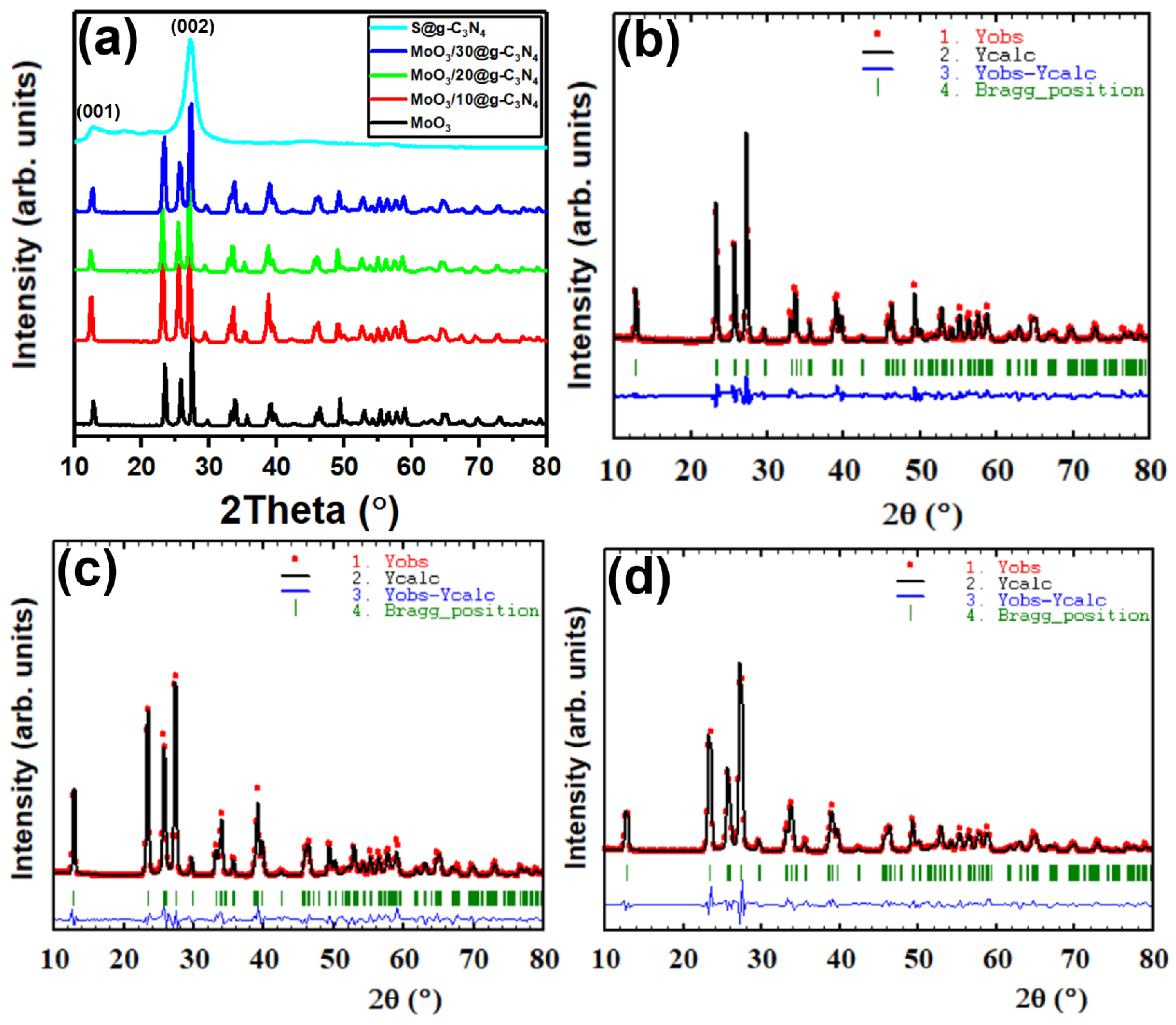
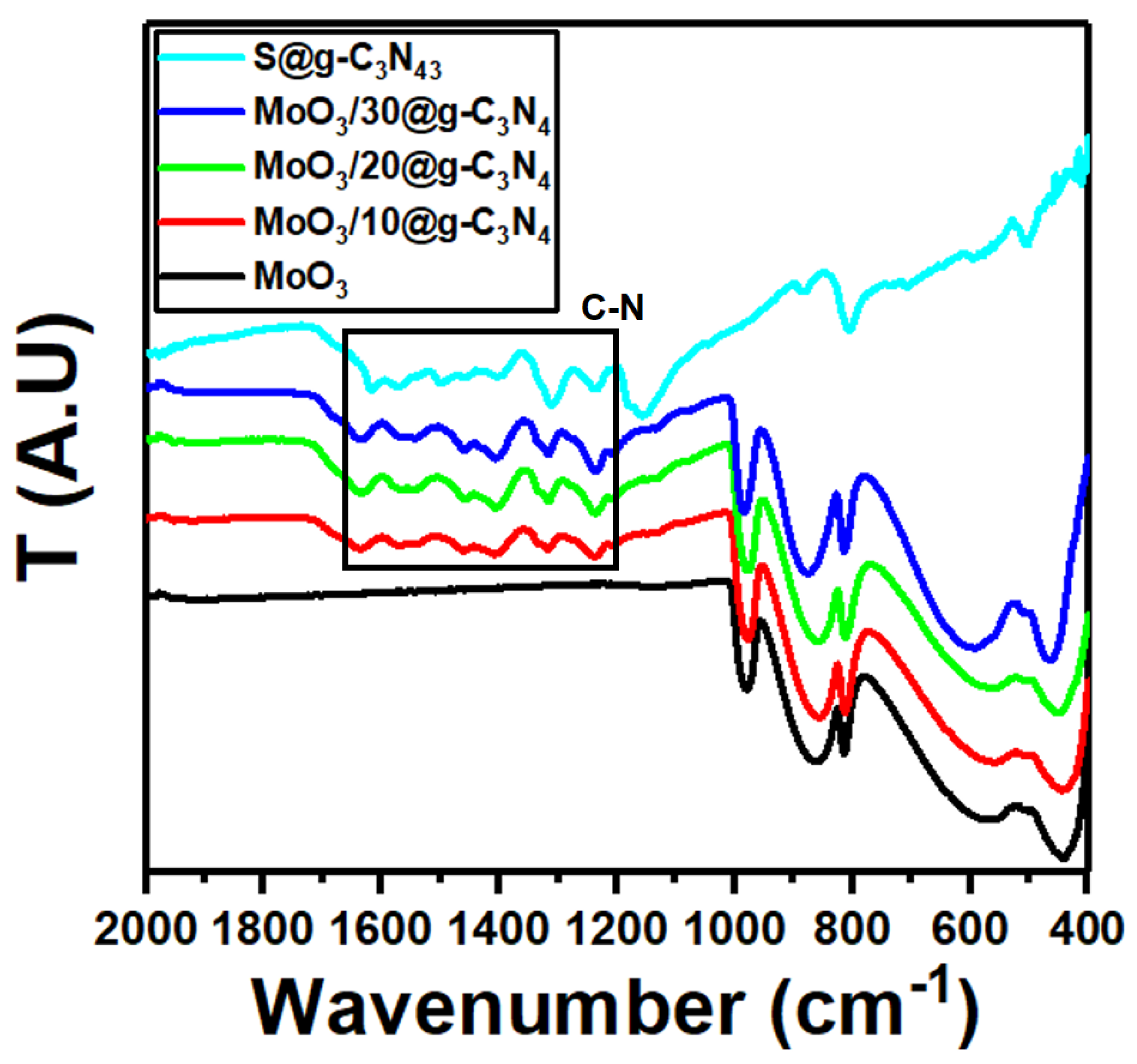
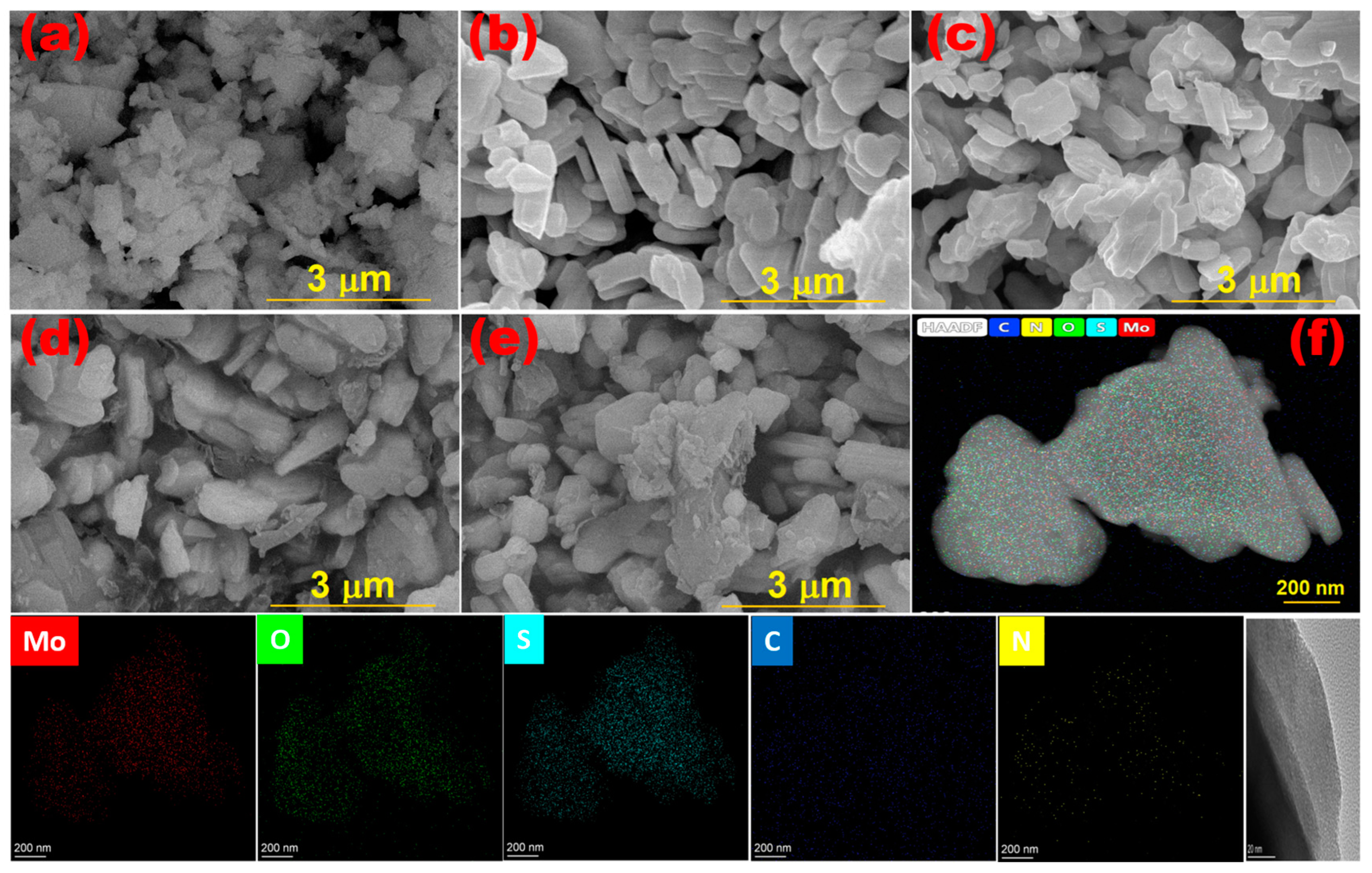
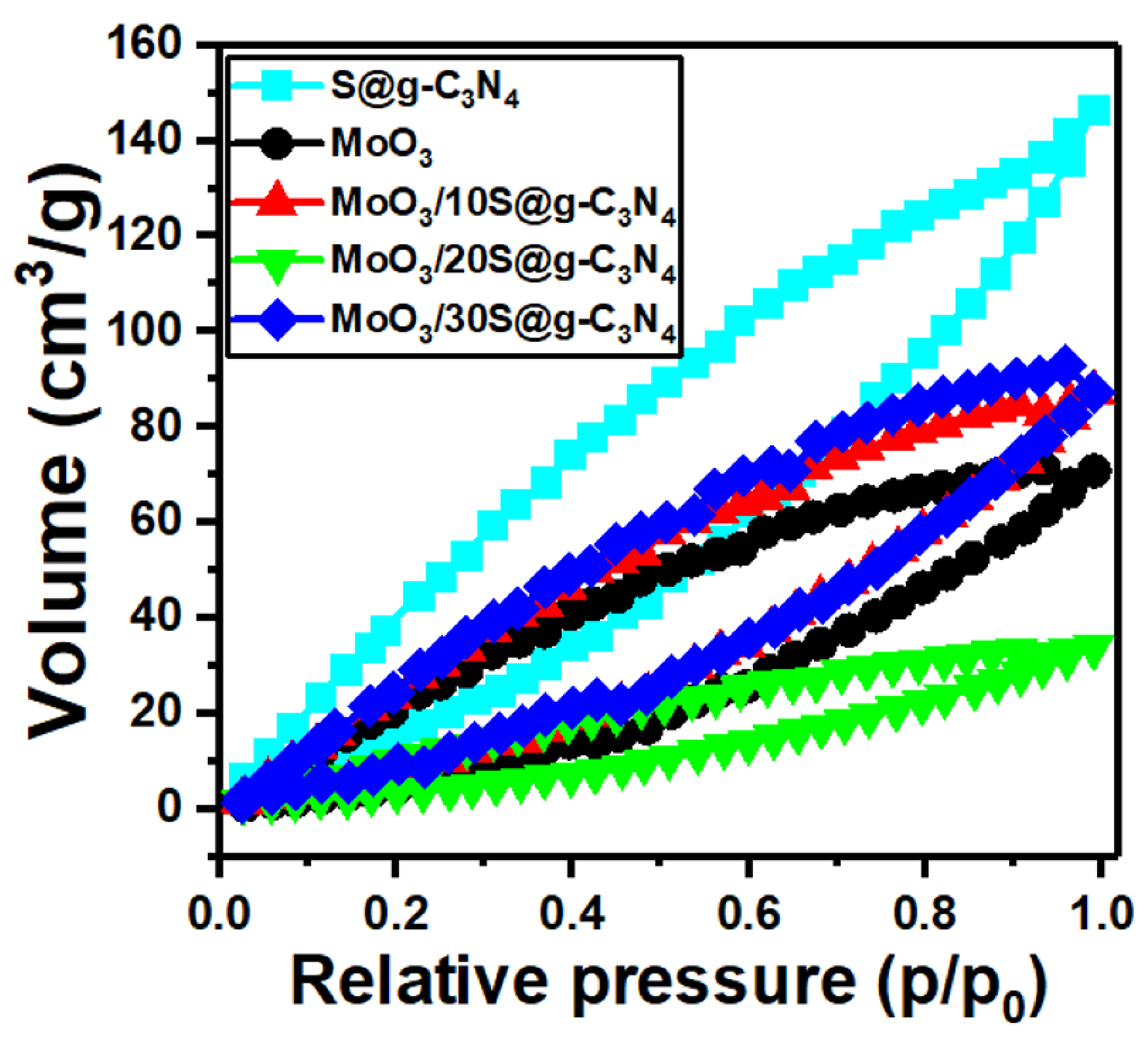
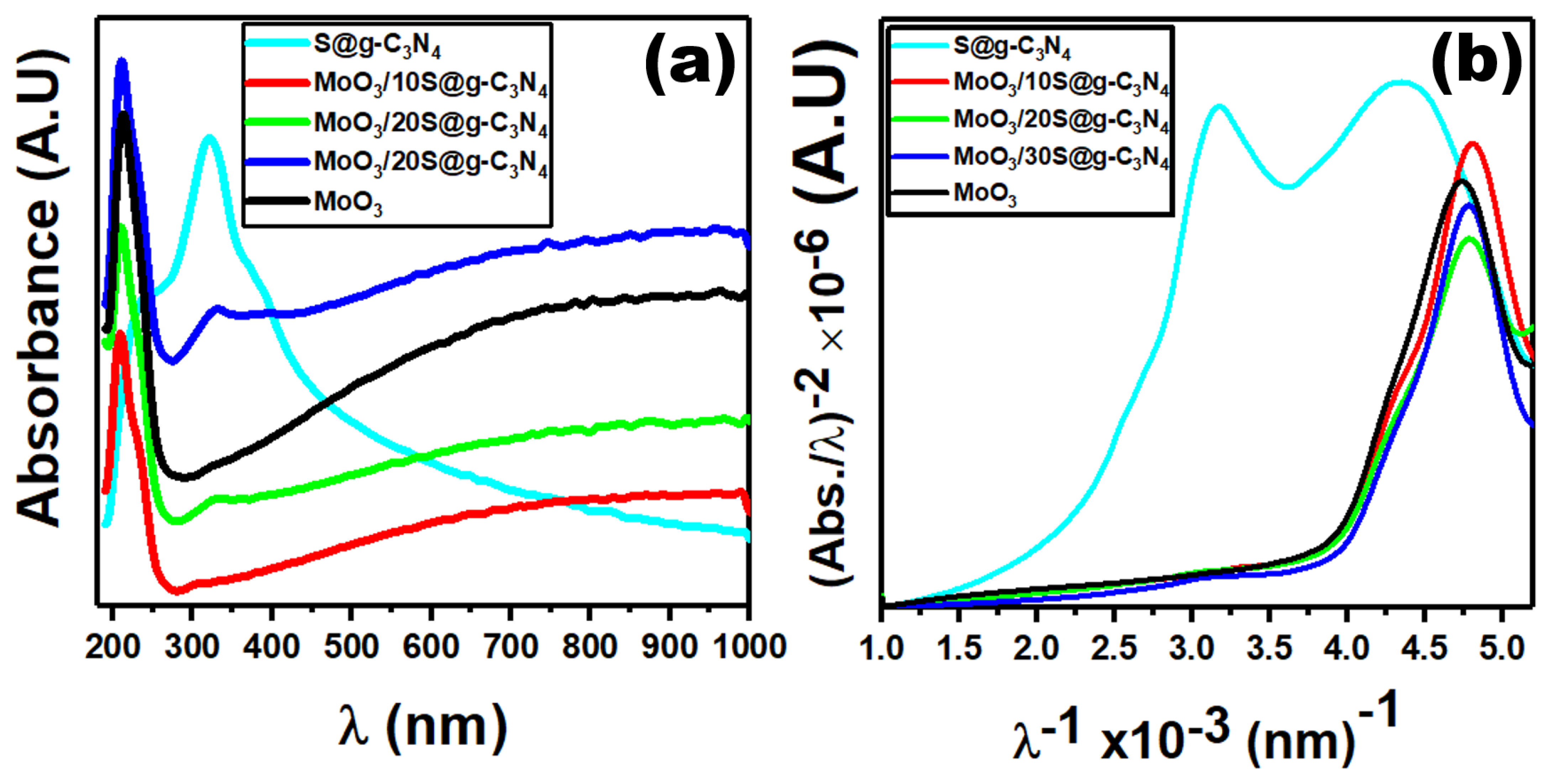
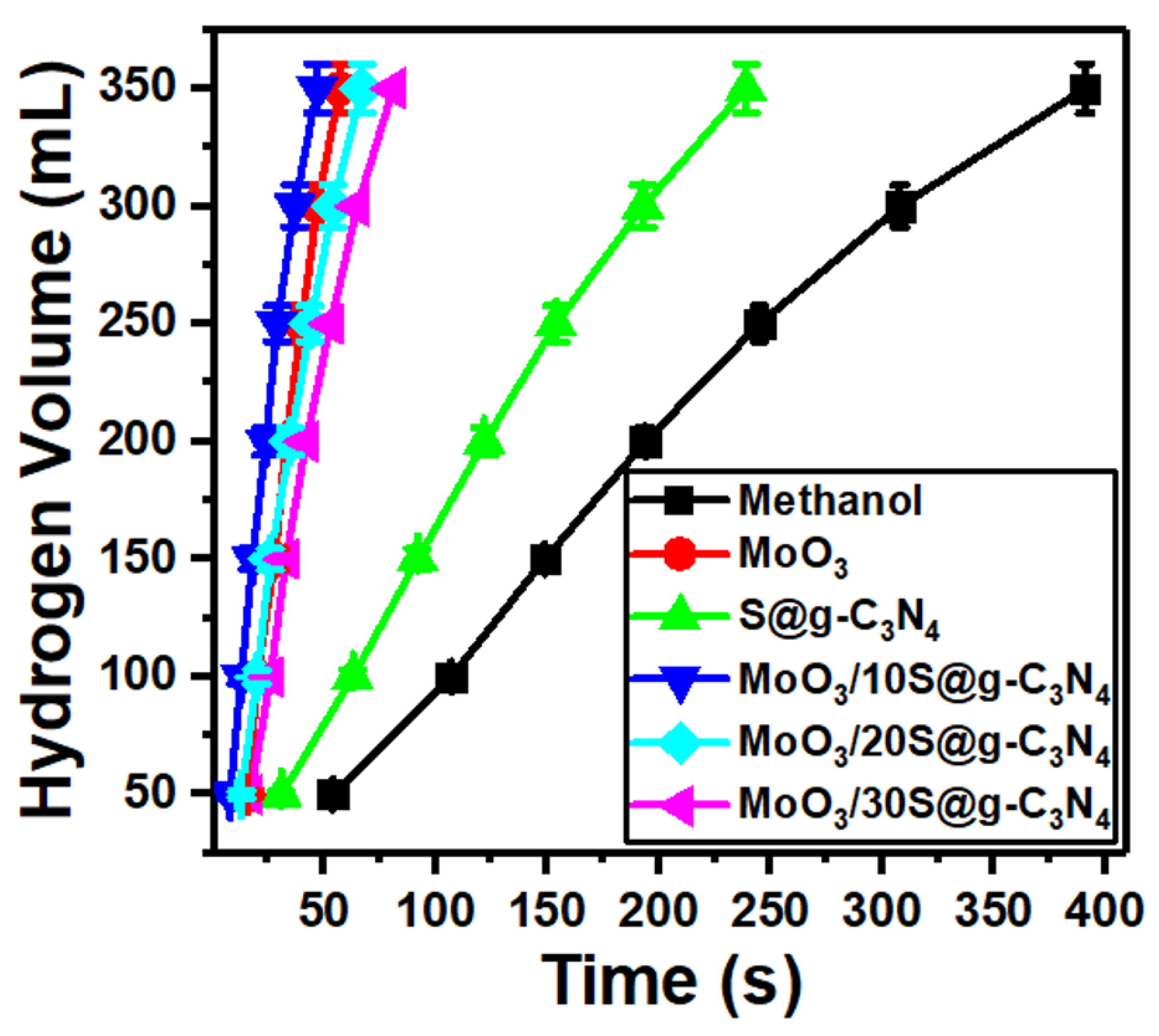
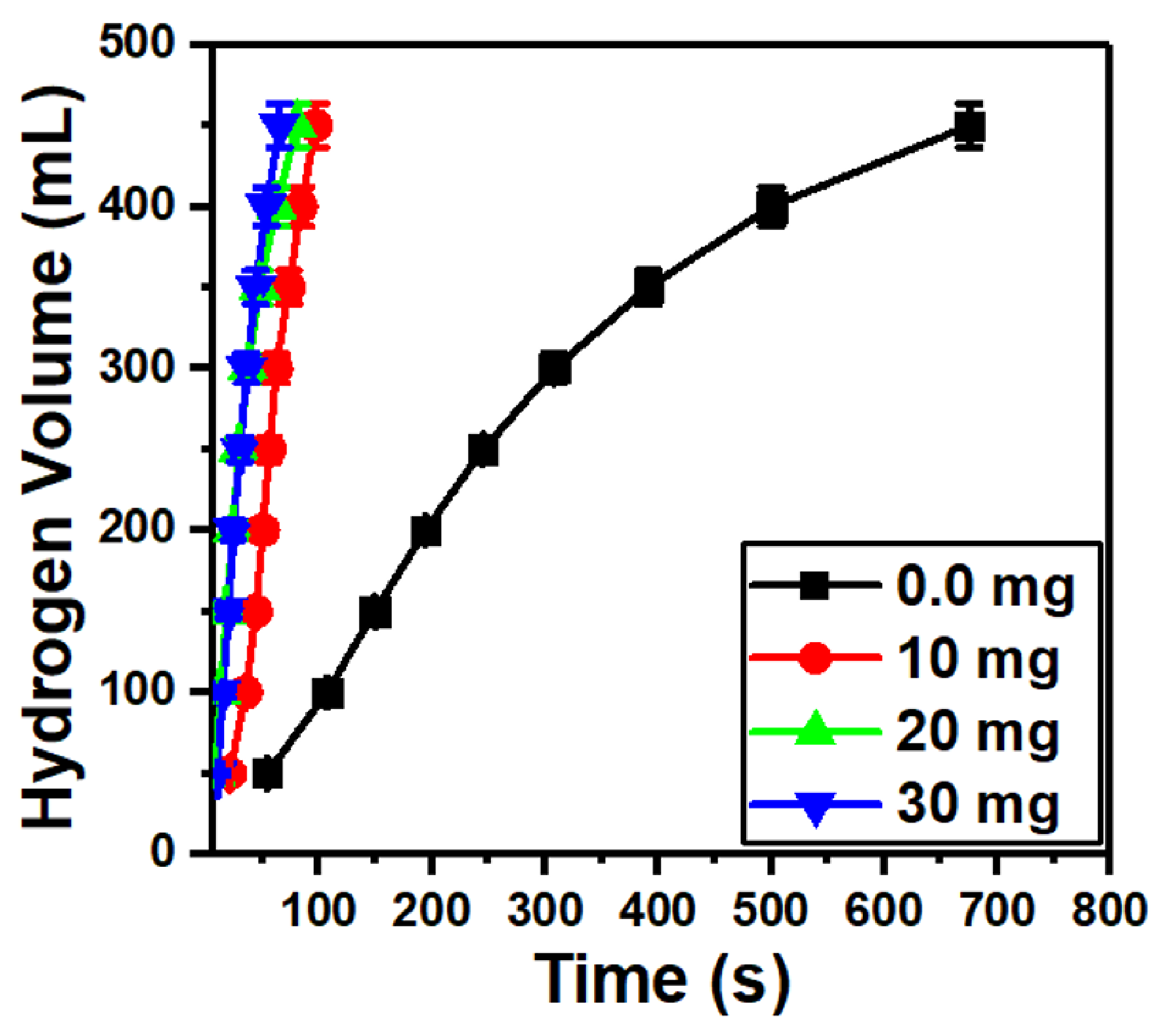
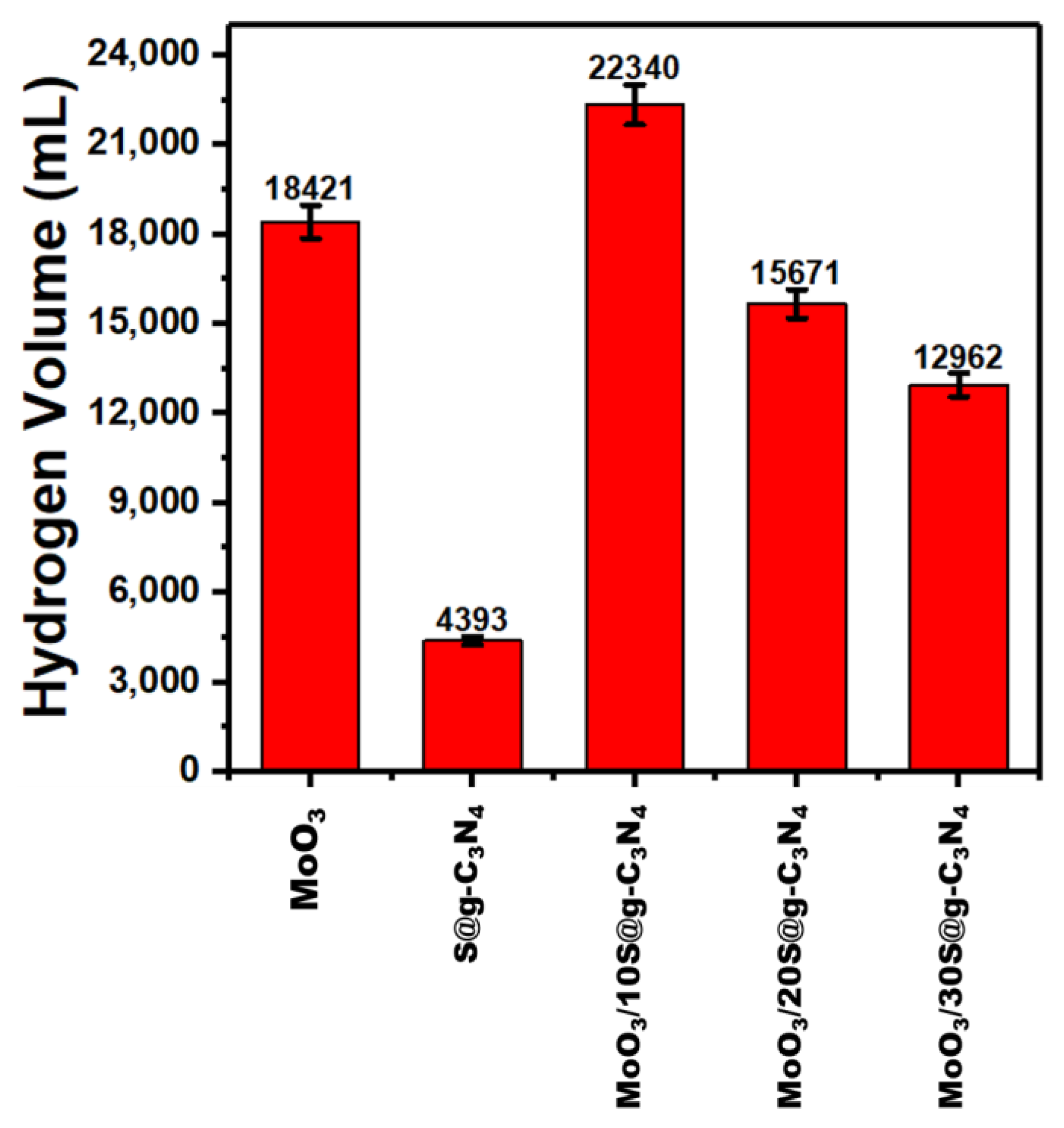
| Sample | Lattice Constant (Å) | Volume (Å3) | Average Nanocrystals Size (nm) | Micro Strain | ||
|---|---|---|---|---|---|---|
| a | b | c | ||||
| MoO3 | 3.96 | 13.86 | 3.69 | 202.5 | 30 | 0.00004 |
| MoO3/10CN | 3.96 | 13.92 | 3.69 | 203.4 | 23 | −0.042 |
| MoO3/20CN | 3.95 | 13.84 | 3.69 | 201.7 | 28 | −0.0037 |
| MoO3/30CN | 3.95 | 13.86 | 3.69 | 202.02 | 20 | −0.030 |
| Catalyst | Form | Hydrogen Evolution Rate (mL/g·min) | Ref. |
|---|---|---|---|
| Ni2P | Powder | 3700 | [62] |
| Ru/C | Powder | 6060 | [63] |
| g-C3N4-SiO2-N | Powder | 11,400 | [53] |
| Ru5Co/C | Powder | 9360 | [63] |
| B and O doped g-C3N4 | Powder | 11,600 | [61] |
| Ru/NiO-Ni | Foam | 6000 | [64] |
| g-C3N4-TiO2-P | Powder | 14,750 | [55] |
| C-KOH-N | Powder | 20,100 | [65] |
| MoO3/10S@g-C3N4 | Powder | 22,340 | This study |
Disclaimer/Publisher’s Note: The statements, opinions and data contained in all publications are solely those of the individual author(s) and contributor(s) and not of MDPI and/or the editor(s). MDPI and/or the editor(s) disclaim responsibility for any injury to people or property resulting from any ideas, methods, instructions or products referred to in the content. |
© 2023 by the authors. Licensee MDPI, Basel, Switzerland. This article is an open access article distributed under the terms and conditions of the Creative Commons Attribution (CC BY) license (https://creativecommons.org/licenses/by/4.0/).
Share and Cite
Alshammari, A.H.; Alshammari, M.; Alhassan, S.; Alshammari, K.; Alotaibi, T.; Taha, T.A.M. MoO3/S@g-C3N4 Nanocomposite Structures: Synthesis, Characterization, and Hydrogen Catalytic Performance. Nanomaterials 2023, 13, 820. https://doi.org/10.3390/nano13050820
Alshammari AH, Alshammari M, Alhassan S, Alshammari K, Alotaibi T, Taha TAM. MoO3/S@g-C3N4 Nanocomposite Structures: Synthesis, Characterization, and Hydrogen Catalytic Performance. Nanomaterials. 2023; 13(5):820. https://doi.org/10.3390/nano13050820
Chicago/Turabian StyleAlshammari, Alhulw H., Majed Alshammari, Sultan Alhassan, Khulaif Alshammari, Turki Alotaibi, and Taha Abdel Mohaymen Taha. 2023. "MoO3/S@g-C3N4 Nanocomposite Structures: Synthesis, Characterization, and Hydrogen Catalytic Performance" Nanomaterials 13, no. 5: 820. https://doi.org/10.3390/nano13050820
APA StyleAlshammari, A. H., Alshammari, M., Alhassan, S., Alshammari, K., Alotaibi, T., & Taha, T. A. M. (2023). MoO3/S@g-C3N4 Nanocomposite Structures: Synthesis, Characterization, and Hydrogen Catalytic Performance. Nanomaterials, 13(5), 820. https://doi.org/10.3390/nano13050820






